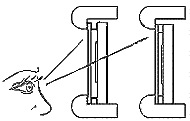Jan 19th 2016
Why Picture Frame Spacers?
Picture frame spacers protect paper borne art and photographs from mold growth, image transfer, water staining, and adhesion to the glass due to condensation on the inside of the glass.
Damage to Art
Paper borne art and photographs held in contact with the glass in a frame may suffer mold growth, image transfer, water staining, and adhesion to the glass due to condensation on the inside of the glass. These spacers provide the proper airspace to help prevent this damage.
Buckling
Paper expands and contracts with changes in humidity. Lack of air circulation across the face of the paper will result in buckling due to slight differences in the humidity content of the paper. (i.e.; The edges and corners may be more humid than the central area). Proper airspace will allow the air to circulate and equalize the humidity across the face of the paper which will help prevent this buckling.
Glossy Prints
These spacers will prevent "Newton Rings" and the wet spots that appear on photographs and glossy prints by preventing the art from contacting the glass.
Needlework
When framing needlework with glass, these spacers will allow the piece to "breathe" helping to prevent thread rot and mold growth by providing the necessary air circulation across the face of the piece. Using spacers will also allow you to achieve a fully padded look without crushing large stitches and knots against the glass.
Preservation Framing
These spacers are quality products for the framer and conservator. The plastic is neutral pH and has no plasticizers to harm fine art. (Test report available). They are made from KOSTAR®, a co-polyester made by Eastman Chemical Co. The acrylic adhesive used on Econospace is neutral pH and will not outgas harmful chemicals. (Of course, the adhesive should be adhered to the glass, not to the art).
Mini Shadow Boxes
The larger Framespace shapes make excellent mini shadow boxes. They're quick and easy to install, are mechanically permanent in the frame, and can be painted or backed with colored mat board.
Caution
You must allow for the free expansion and contraction of
the art and backing materials in a frame. Any pressure against the
backing will cause the art to buckle with changes in temperature and
humidity. In wood frames, don't "pinch" the backing in the frame with
diamond points, brads, or fitting staples. Allow a little looseness so
the art can expand and contract freely.
In metal frames, the commonly used spring clips apply too much
pressure against the backing causing the art to buckle. It is
recommended to glue matboard or foamcore strips onto the edge of the
backing to almost fill the space remaining behind the backing. Leave it
all a little loose to prevent buckling.
In environments that have great changes in humidity, temperature,
dust, or insects, it is recommended to seal the glass-art-backing
package with tape. This will help protect the art from buckling, dirt,
and other damages. The adhesive against the edge of the freshly cut
backing or foam boards will also adhere to all the little particles that
always seem to escape into the frame job.
A Note About Allowances
An appropriate allowance between the glass size, art package size, and the frame size is necessary to allow for inaccuracies in measuring, marking, cutting, and squareness of all the materials used in a frame. Expansion and contraction of all materials from temperature and humidity must also be considered.


